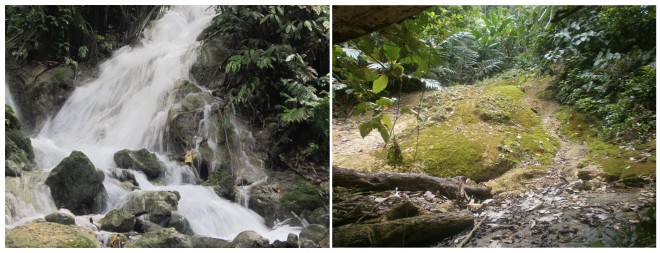
Left photo shows water gushing from the Maputi Spring in Agusan del Sur before the 7.2-magnitude earthquake that struck Central Visayas on Oct. 15, 2013. The second shows a dried up well after the earthquake. The spring is a main source of water for residents in Rosario town, Agusan del Sur. CHRIS V. PANGANIBAN/INQUIRER
ROSARIO, Agusan del Sur – The spring that supplied practically the entire municipality of Rosario with drinking water dried up following Tuesday’s 7.2 magnitude earthquake that shook Bohol and other parts of the Visayas as well as Mindanao, killing up to 180 people.
The drying up of the Maputi Spring, where a World Bank-funded P47-million water system was being installed, has puzzled residents of eight of the municipality’s 11 barangay (villages) who found themselves waterless the day after the earthquake, which was felt here at Intensity 3.
Even local officials were at a loss as to why the spring dried up so suddenly when it was flowing abundantly hours before the tremor struck.
Vice Mayor Julie Chua said he suspected that the earthquake triggered major movements in the earth’s plates underneath this town, which in turn blocked the flow of water from the underground aquifer.
He said the municipal government has asked the Mines and Geosciences Bureau to look into the matter and explain the phenomenon to the townsfolk.
Chua said local officials wanted to know if there was a possibility water would flow again on its own or if something could be done to bring the spring back to life. Otherwise, the multimillion-peso water system being installed would be a total loss.
Joselito Serrano, a member of the staff at the Municipal Planning and Development Office, said the water supply project was begun in July last year by the Mindanao Rural Development Program.
Even if it was just about 80 percent completed, it had started supplying drinking water to thousands of residents of the town center and seven adjoining villages, Serrano said.
He said Maputi Spring had the potential to supply potable water to the nearly 40,000 residents of this second-class municipality.
While officials here suspected that movement in the earth’s crust caused the spring to dry up, some residents said they believed that unabated illegal small-scale mining near the Maputi Spring watershed was to blame.
They said the illegal mining activities might have disturbed the natural flow of water from underground.
Chua said MGB geologists might be able to explain what actually happened as little is known about the spring. Before the World Bank-backed water system was undertaken, no geological analysis had ever been conducted at the site, he said.
Meanwhile, residents were getting water from neighbors with deep wells, which apparently had not been affected.
RELATED STORY